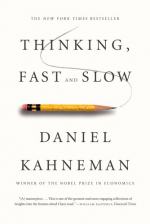
|
| Name: _________________________ | Period: ___________________ |
This quiz consists of 5 multiple choice and 5 short answer questions through Chapters 10 - 14.
Multiple Choice Questions
1. What is described as the currency consumed by the nervous system above all others, and which serves as a currency for effortful mental activity?
(a) Vitamin B.
(b) Glucose.
(c) Testosterone.
(d) Estrogen.
2. The author provides an excerpt related to "norm theory" that comes from an essay he had written with what psychologist?
(a) Daniel Gilbert.
(b) Danny Oppenheimer.
(c) Shane Frederick.
(d) Dale Miller.
3. What region of the brain is substantially more developed in humans than other primates and is involved in operations associated with intelligence?
(a) The brainstem.
(b) The cerebellum.
(c) The occipital lobe.
(d) The prefrontal area.
4. With whom did Daniel Kahneman conduct a study on pupil dilation at the University of Michigan?
(a) Mihaly Csikszentmihalyi.
(b) Nassim Taleb.
(c) Jackson Beatty.
(d) Larry Jacoby.
5. What example is presented in the opening of Chapter 1 to demonstrate slow thinking?
(a) A picture of an angry woman.
(b) A picture of a stream.
(c) A multiplication problem.
(d) A compound sentence.
Short Answer Questions
1. What do scientists call observations that are produced entirely by some aspect of the method of research?
2. What do we lose touch with when we are uncomfortable or unhappy?
3. What book did Abert Michotte write in 1945?
4. The author describes a phenomenon discovered by Roy Baumeister's team wherein an effort of will is tiring, and if you have to force yourself to do something, you are less able to exert self-control when the next challenge appears. What is this phenomenon named?
5. What branch of medicine deals with the incidence, distribution, and possible control of diseases and other health factors?
|
This section contains 280 words (approx. 1 page at 300 words per page) |

|




